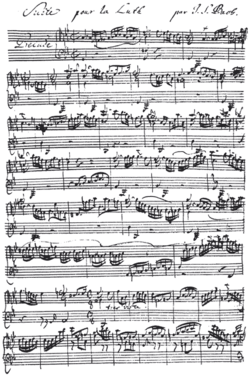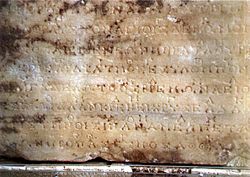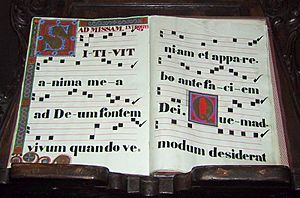Musical notation facts for kids

Music notation is like a special language for writing down music. It helps musicians know exactly how to play a song. Imagine trying to tell someone how to play a complicated piece of music just by humming it! Writing it down makes it much easier.
Today, most musicians in Western countries use a system where musical notes are placed on a stave. This is a set of five parallel lines with four spaces between them. But people have used many different ways to write music throughout history. Some of these older ways are still used in different cultures around the world.
When music is written down, a composer (the person who creates the music) can share their ideas with others. Anyone who can "read music" can then play or sing that piece. If music isn't written down, people have to learn it by listening and copying. This is how traditional folk music was often passed down.
Contents
Early Ways to Write Music
Ancient Cuneiform
The very first ways of writing music were found on clay tablets. These tablets used a writing style called cuneiform. Some music from around 2000 B.C. has been found in Nippur. It gives us a rough idea of how the music might have sounded. Another tablet from 1250 B.C. even shows the names of the strings on a lyre. These are the oldest written music records we have!
Music in Ancient Greece
Musical notation from Ancient Greece was more detailed than cuneiform. It showed the pitch (how high or low a note is) and how long each note should last. It sometimes even hinted at the harmony. This system was used from at least the 6th century BC until about the 4th century AD.
Early European Notation
When music started to be written down in Europe, it was mainly for the Roman Catholic church. monks used a system of dots and strokes called neumes. These neumes showed if the notes went up or down, but they didn't show how long each note lasted. They might have been used as reminders for people who already knew the music.
Over time, people realized they needed a system to show the exact pitch of each note. The first stave was just one horizontal line. Slowly, it grew to four lines. An Italian monk named Guido d’Arezzo, who lived in the 11th century, helped develop this system. His ideas soon led to the way we write music today. By the 16th century, everyone was using the five-line stave.
By the end of the 17th century, a system of bars (also called measures) was used everywhere. At first, bar lines just showed which notes should be played together. Later, the system we use today developed. In this system, each bar lasts the same amount of time and has a specific number of beats. This became standard for most European classical music by the late 1600s.
Modern Music Notation

Today, we use a five-line staff. The pitch of a note is shown by its position on the staff. There might also be sharps or flats placed in front of some notes. Music is always read from left to right.
A staff usually starts with a clef. This symbol tells you exactly which notes are to be played. If notes are very high or very low, they can be placed on extra short lines called ledger lines, above or below the staff.
After the clef, there is often a key signature. This shows the key of the piece. It tells you which sharps or flats will be used regularly throughout the music.
Next comes the time signature. Bars divide the music into regular groups of beats. The time signature shows how these beats are grouped.
Above the music, you'll often find words that tell you the tempo (speed) of the piece. Throughout the music, there will be dynamic marks. These tell musicians how loud or soft to play.
For vocal music, the words are written underneath the notes.
When a large group like an orchestra plays music, it's written in a "score". A score shows the music for all the instruments at once. The conductor uses the score. Each player, however, uses a "part," which only has the notes they need to play. All the parts for a piece are called a "set of parts."
Other Ways to Write Music
- Chord Charts: Guitar players often use chord charts. These show the names of chords (like C7 or Em) written above the music or song lyrics.
- Tonic Sol-fa: About a hundred years ago, amateur musicians used a system called tonic sol-fa. This showed the names of notes in a scale (like doh, ray, me).
- Tablature: Music for instruments like the Lute in the Renaissance and Baroque periods was often written in a system called tablature. Some modern composers also use it.
- Graphic Notation: Some modern composers, like John Cage, have created music using drawings. This is called graphic notation.
- Braille Music: Music can also be written in Braille for blind musicians.
- Computer Notation: Today, computers are often used to create music. This has led to new forms of notation used in different software programs. The MIDI file format, for example, stores information about notes like pitch, length, speed, and volume. This can control MIDI instruments.
- There are also other systems used for non-Western music around the world.
Other Pages
Images for kids
-
Hand-written musical notation by J. S. Bach (1685–1750). This is the beginning of the Prelude from the Suite for Lute in G minor, BWV 995 (transcription of Cello Suite No. 5, BWV 1011).
-
Byzantine music notation in the first edition (1823) of Macarie Ieromonahul's anastasimatarion, a hymnal with daily chant (including resurrection troparia called apolytikia anastasima) in oktoechos order, each section began with the evening psalm 140 (here section of echos protos with Romanian transliterated in Cyrillic script)
-
Chrysanthos' Kanonion with a comparison between Ancient Greek tetraphonia (column 1), Western Solfeggio, the Papadic Parallage (ascending: column 3 and 4; descending: column 5 and 6) according to the trochos system, and his heptaphonic parallage according to the New Method (syllables in the fore-last and martyriai in the last column) ( Chrysanthos 1832, p. 33)
-
An example of modern musical notation: Prelude, Op. 28, No. 7, by Frédéric Chopin
-
An example of Znamenny notation with so-called "red marks", Russia, 1884. "Thy Cross we honour, oh Lord, and Thy holy Resurrection we praise."
-
Tempyō Biwa Fu 天平琵琶譜 (circa 738 AD), musical notation for Biwa. (Shōsōin, at Nara, Japan)
-
Amazing Grace in numbered notation.
See also
 In Spanish: Notación musical para niños
In Spanish: Notación musical para niños


















